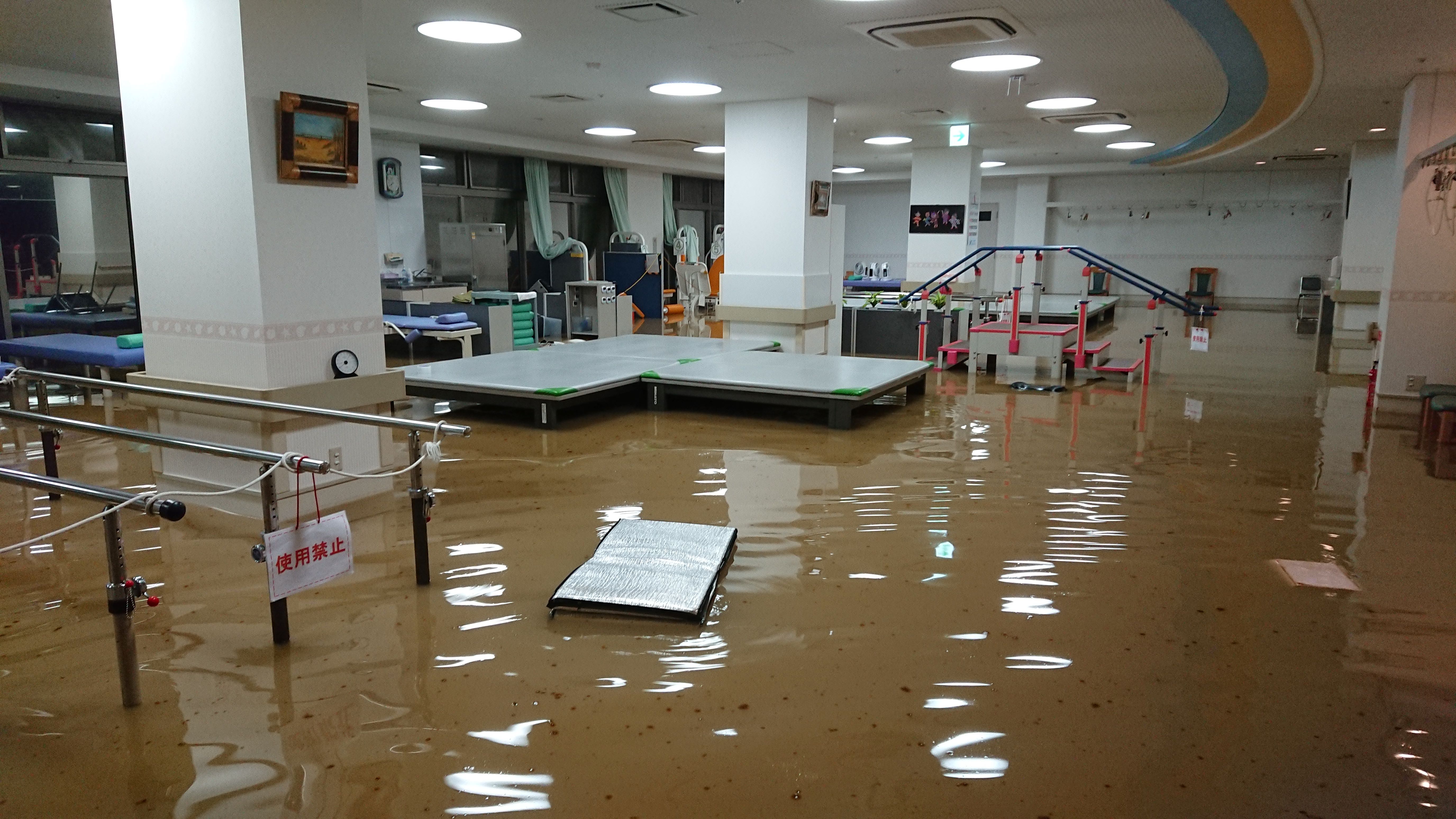ASOURCE®TIMES

医療法人順天堂 順天堂病院 事務長
白濱 好美
気候変動の影響で、水害のリスクは年々高まっていることが指摘されています。佐賀県にある医療療養型病床(115床)と介護老人保健施設(70床)を運営する医療法人順天堂は、2019年、2021年と相次いで豪雨による水害に見舞われ、多額の損害を受けました。事務長の白濱好美氏に2度の水害によって得た教訓と経験をもとに取り組んでいる水害対策について伺います。

当法人は、1999年に三方を六角川(一級河川)に囲まれた現在地に新築移転した際、この場所が浸水危険地域であることはわかっていたので、盛り土で嵩上げした土地に建物を建築しました。さらに「災害関連死」を防ぐために施設完結型の避難を目指し、非常食の備蓄はもちろんのこと、水を安定的に供給する浄水装置や、ガスの供給が停止しても最低5日間は持ち堪えられる大容量のガスタンクを備え、屋上には自家発電装置を設置するなどライフライン対策にも取り組んできました。
しかし、2019年の水害では建物が約25cm床上浸水し、3日間の孤立状態を余儀なくされました。超音波画像診断装置など事前に動かせる医療機器は安全な場所に移動して無事だったものの、X線レントゲン装置、乳房X線撮影装置(マンモグラフィー)、CT装置などの大型医療機器やリハビリ機器は浸水によりすべて失いました〈写真1〉。不幸中の幸いだったことは、人的被害がなかったことです。このことは診療を速やかに再開するうえでとても重要なことだったと考えています。
2019年の水害では被災後、13日目で診療を再開しました。甚大な被害を受けながらも、短期間で再開が出来た要因としては、水害を想定して3階に設置していた電子カルテのサーバーやパソコン端末に被害がなく診療記録が残っていたこと、医療機器の一部が使えたこと、ライフラインを自前で確保していたことなどが挙げられます。
〈写真1〉

2019年の水害ではリハビリ室も被災。リハビリ機器の多くが使用できなかった。
2019年の教訓を踏まえ、出入り口や内部のドアなど20か所に止水板を新設しましたが、2021年の水害の際には残念ながら役に立ちませんでした。2019年の床上浸水は、明け方に短時間で降った集中豪雨に加え、近くの工場から油が流出し、汚染水の被害を広げないように排水を止めたことが原因でした。被災後、工場から予防策が示されたこともあり、相当量の雨が降ったとしても通常どおり排水処理ができれば床上浸水は50㎝程度だと見込み、70㎝の止水板を設置しました。
ところが2021年は2019年とは雨の降り方が異なり、大雨洪水警報級の大雨が4日間降り続いたため、排水処理が追いつかず、床上浸水1mの被害に遭いました〈写真2〉。そして、2019年と同様に大型医療機器、リハビリ機器などをすべて失い、再び億単位の損害を被ったのです。当法人が2度にわたる水害から学んだのは「水位や雨量を予測して対策しても想定外のことが起こるため、浸水は免れない」という教訓でした。
そこで発想を転換し、浸水を前提に対策を講じることにしました。大型医療機器を2階に移設すると同時に、大型医療機器のラインナップを見直し、必要な機器だけを残しました。2019年の被災後に導入したMRIは2021年の水害で使えなくなってしまったので、これを機に廃止しました。また、乳房X線撮影装置も利用者が少なかったため、再設置しないこととしました。
また、2021年の水害の際、1階の机の上に置いていた物が水浸しになったことを踏まえ、大切な物を安全な場所にすぐに移動させられるよう室内の壁の上部に棚を造設しました。物品の損害を最小限度に止めるには、重要な紙書類などをいつでも持ち出せるように普段からの整理整頓が重要であり、徹底するようにしました。
〈写真2〉

2021年、浸水は最高水位である床上1m、道路からは2m40cmに達した。
対策として有効だったのは避難訓練です。当法人では2017年から年1回、水害を想定した避難訓練を行ってきました。避難訓練を検討する過程で、体が不自由な高齢者を移送するにはベッドより車椅子のほうが効率的だとわかりました。車椅子での移送が訓練を通して徹底されていた現場では、患者さんの協力も得られて大きな混乱なく避難できました。ただ、大雨洪水警報などが出た際には夜勤職員(平時は10人)を3人増員して対応しているものの、夜間の避難は時間がかかります。一方でスピードよりも安全に確実に避難してもらうことが重要だと考えています。そのためにも訓練を繰り返し、職員や患者さんが避難に慣れておくことが肝心です。
また、対策が不十分だったのは職員の安全確保です。2019年の水害では胸や腰まで水に浸かりながら出勤してきた職員が何人もいました。しかし、水難事故のおそれもあったので、出勤停止命令を一斉に連絡すべきだったと反省しています。その後、出勤停止命令の判断基準と連絡体制を整備しました。
さらに2019年の水害では3日間孤立状態になり、職員を交代させる手段がありませんでした。町役場に相談したところ、町のボートで職員の移送を引き受けていただき、2021年の水害の際には朝一番にボートで駆けつけてもらえました。人員確保の手段については行政と協議しておくことも必要です。
2度にわたり被災したことで、職員には「今年も水害が起こるかもしれない」という危機感があります。災害の被害を最小限に抑えるためには、いつ水害が起こっても対応できるように日頃の備えを怠らず、院内全体で常に災害に対する意識を持つことが最も重要だと思っています。